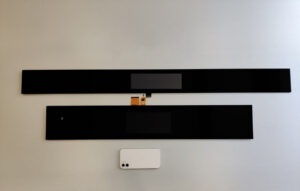
Reaching out for new applications with Yeebo’s Optical Bonding technologies
The benefits of optical bonding in noticeably enhancing readability under all shades of light, preventing fogging as well as absorbing shocks and vibrations, are well-known in rugged and outdoor human-machine interfaces.
In most cases, though, optical bonding seems to be confined to a single connection between the cover lens or touch panel and TFT. When a project requires bonding multiple TFTs within a single cover lens or just a screen in a relatively wider cover lens, the approach needs a rethink.
Through extensive know-how in optically clear adhesives and bonding processes, and worldwide market experience, Yeebo has honed its technology to cater for multi-screen optical bonding. The technology, which is scalable to cover lenses as wide as 1,000 mm, is particularly suited to shelf labelling systems and digital signage applications housing several displays, rack-mounted letterbox user interfaces in broadcast studios, and consumer & professional appliances.
In a typical configuration, customers use two or more Yeebo’s 3.9” IPS TFTs (YB-TG480128S01A-N-A0) optically bonded to a single cover lens.
Yeebo’s optical bonding technologies do not stop at flat cover lenses: they now include curved surfaces to open a new array of designs and applications. From mobile ticketing devices and access control systems to marine navigation dashboards and dynamic information displays, Yeebo’s curved lenses are set to stimulate a new wave of ergonomically sound, innovative TFT designs.
Contact Yeebo Display Europe today to stretch your imagination on your next project:
+44 (0) 203 287 6886
info@yeeboeurope.com
www.yeeboeurope.com
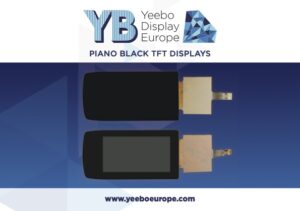
Yeebo adds visual impact with Piano Black TFT displays
Designing the user interface of today’s applications is getting more refined thanks to Yeebo’s expertise in TFT module design and market applications. With vertically integrated cover lens and touch panel manufacturing, and a highly automated TFT facility, Yeebo is the natural partner for developing display solutions that push the limits of visual interface design on aesthetic, performance and functionality.
One component attracting growing interest in recent TFT designs is the cover lens. Not only does a well-crafted cover lens protect the screen from mechanical impact and weather conditions, but it also contributes to the overall visual appeal of the final product. Choosing the best cover lens no longer stops at its basic features – material, shape and décor options. New requirements demand that the TFT visible area is purely dark when the screen is inactive, blending display and cover lens with no visual distinction.
Yeebo is at the forefront of cover lens designs with a technology developed by combining low-transflective glass and an engineered optical bonding adhesive. By controlling light transmittance within the stack, the cover lens system completely conceals the TFT when inactive, creating a distinctive Piano Black look.
With this unique feature, companies eager to differentiate the aesthetic of their products, whether it’s a smart health monitor, pro audio equipment or home automation system, can now ensure they stand out from the competition.
Contact Yeebo Display Europe today to discuss how to integrate Piano Black TFT displays into your next project:
+44 (0) 203 287 6886
info@yeeboeurope.com
www.yeeboeurope.com
IPS TFT Modules from Yeebo
Manufactured on robotic production lines in a highly automated facility in Jiangmen (China), Yeebo IPS TFT displays are instantly recognised as top-quality products and competitive in price.
The full range, available with multi-touch options at no added NRE charge, focuses on providing B2B customers with superior image quality, slim package and outstanding reliability in any chosen size from 1.3” to 10.1”.
Unlike traditional TFT, Yeebo IPS displays boast up to 1000:1 contrast ratio, up to 700 cd/m² luminance, all-round viewing and rich colour saturation to finely reproduce eye-catching information under any lighting condition. Designers involved in crafting next-generation devices in healthcare, industrial and consumer electronics, smart city and transportation applications will benefit from this portfolio of power-efficient and highly performing TFTs, whose driver ICs incorporate digital gamma correction and clever driving circuitry. For designs featuring upgradable display sizes, the common signal interface available on Yeebo IPS 3.9”, 4.3” and 5.0” flexibly supports resolutions rising from 428×128 letterbox aspect ratio to 480×272 (16:9) and 800×480 (5:3) respectively.
Equally, marketing and product development teams will enjoy the versatility that Yeebo IPS displays offer: pixel resolutions from 240×240 to 1280×800, portrait or landscape mounting, and a choice of signal interfaces – SPI, MPU, RGB, LVDS and MIPI – to support low-cost microcontrollers and up to feature-rich ARM processors.
Contact Yeebo Display Europe today to get started on your project:+44 (0) 203 287 6886
info@yeeboeurope.com
www.yeeboeurope.com



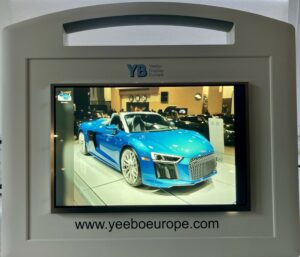
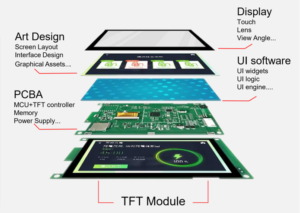
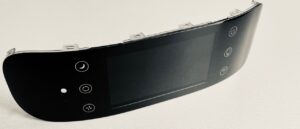
Passive Matrix OLEDs (PMOLEDs) offer several advantages over other display technologies. Here’s a summary of their key benefits:
* High contrast: PMOLEDs provide a high contrast ratio, resulting in crisp, clear images and icons.
* Thin design: Since PMOLEDs don’t require a backlight, they can be extremely thin, making them suitable for compact devices.
* Low power consumption: Especially for static or low-changing content, PMOLEDs consume less power compared to other display types, such as LCDs.
* Wide viewing angles: PMOLEDs offer excellent viewing angles, ensuring consistent image quality regardless of the viewing direction.
* Fast response time: With a fast response time, PMOLEDs provide smooth motion and reduced motion blur, which is beneficial for applications like gaming and virtual reality.
* Cost-effective: PMOLEDs can be more cost-effective than other OLED technologies, making them a popular choice for consumer electronics.
Despite these advantages, PMOLEDs may not be suitable for all applications. Their performance can be limited when displaying dynamic content, and their lifetime may be shorter than other display technologies. However, PMOLEDs remain a popular choice for small displays, such as those in smartphones, smartwatches, and other portable devices.